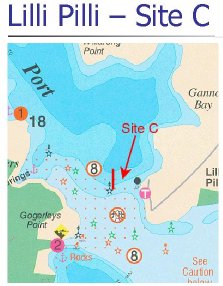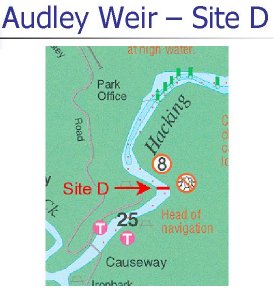What Lives Below the Waves |
Denis Hicks - Underwater Research Group
Good morning. I’m Dennis Hicks. I’m one of the two Vice Presidents of the Underwater Research Group of NSW, which is a community-based dive club spread over Sydney. We have members from the Sutherland area. I’m in Lakemba and we’ve got people as far north as Palm Beach.
The Underwater Research Group started back in about 1952. We’re unsure of the original date, but our records go back to very early 1953 and we know it was well underway by then. A lot of their early diving was based around Port Hacking and in fact, they did a significant amount of research on their own or through involvement with the Australian Museum and some of the Universities as well in the early periods. The club’s had some quite illustrious members. We actually have Steve Parish, Walt Deas and Neville Coleman numbered amongst some of our past members and I know that most people will have heard of them.
At present, we’ve been involved in community research which was supported by a Hacking River Catchment Management Committee grant and we started this back in early 2000. We had four sites and the aim was to establish a baseline of data on the diversity of life within the Port Hacking estuary. Our sites were in four different places and we actually dived on them at four different times: in winter, autumn, spring and summer. We were looking for a list of species and trying to get some idea of their abundance. We were trying to find out what the substrates in the various areas were, and to see whether there was actually much in the way of pollutants in the waterways. We actually expected that there would be quite a lot of pollutants but one of the things we found is that there were very few actually. It’s actually relatively clean.
Our Transects
We had two transects at each site. Each of these transects was 100m long and we had tags every 10m. When we actually did our research, we’d send divers down and we’d actually look at what was at each of those 10m tags. Our original four sites were (1) just inside Jibbon, (2) at Shiprock, which created some problems because, although we had the support of Waterways [Authority] as well as Fisheries, we had problems diving in “The Channel”. Even though they gave us their support, they didn’t seem to pass the information on to the actual people who were policing the channel. With the research that’s continuing at the moment, we’ve actually decided to try not to dive on the weekends in those places now so that we avoid most of the boating and hopefully avoid any problems with having Waterways trying to move us along. (3) The transect at the sandbar at the deep hole behind Lilli Pilli Point is quite interesting because, whilst it’s basically sand, it goes from approximately 2m, down to about 30m in that deep hole, and we don’t even go all the way down to the deepest part. But it’s quite an interesting spot in relation to its actual geography. (4) And the Hacking River up at Wonns Beach. I’ve haven’t dived up there, but that’s supposed to be very interesting because its affected by a lot of tannins that get washed into the water from the plant life. |
 |
| In each of these places we actually do two transects about 50m -100m apart. We've got two sites at Shiprock. We're actually lucky because we use the channel markers as one end of them so we can get it fairly accurate. The transect at the deep hole runs towards the start of the deepest part of the hole from up on the sandbank. And the final one up near Audley is just around the corner from the causeway. They've had some interesting dives up there where they've literally had to follow the transect line by holding on to it because of all the tannins in the water. |



 |
We've added four new transects since we got a new grant at the start of last year to extend our research. We only dive on one transect at each of these places because the depth means that we'd be spending too much time underwater in order to get them all done. Unfortunately the weather also makes them inaccessible at times. So Marley Point, for example, hasn't been done the last two times that we were due to do the research firstly because of a mechanical failure and the next time because of the weather.
Our Dive Teams
While some of our club members have some scientific background or research background, most of us are just the average interested diver. So we've tried to set it up with people in the dive teams who can record what's there. But we've also included a videographer where possible, and a photographer so that we can get an actual photographic record of what's under there. Anything we miss, we can attempt to identify from the photos. They also allow us to photograph unusual or unexpected life that we find down there, some of which is quite interesting and which we know is there already, like the blue-ringed octopus. But sometimes we do get unusual ones.
Our photographer puts a quadrat, which we've constructed, down at each tag and then photographs it attempting to get all the quadrat in the photo. At places like Jibbon, this can sometimes be difficult because the transects ends up in about 1m of water and the wave action makes it quite difficult. We're looking at recording the type of bottom that's there. So we get seagrass at Jibbon, for example, along with some sponges and things like that. At Shiprock we not only have a rocky substrate but we've also got a sandy bottom for a fair bit of it as well, so we get quite different information from each site.
The first surveys were done in February 2000 and, as I've already mentioned, we've since extended the research with a second grant. There is some of the information that we've collected so far. So we've got substrate cover. Depending on where you are at Jibbon, there can be quite a lot of sand. That sand does actually have a reasonable amount of seagrass on it, which is of course interesting if you've got boats coming in to anchor over near Jibbon Beach. We were able to identify some of the fish species completely because we recognise them very well.
We've got evidence here of some pollution but there isn't a huge amount as I said before that we've noticed which is surprising. For some of the species we've got common names for but not scientific names and this depends on a number of things, including the groups of fish that they belong to, and sometimes on the observational skills and background knowledge of the person who's actually recording. Some of those species are common to different sections.
And something we've been finding a fair bit of, not just in Port Hacking but its also found in Sydney Harbour as well, is Caulerpa taxifolia. It's an invasive weed and is one of the reasons that we are interested in doing our community-based research. Caulerpa tends to cover everything, take over everything and it's quite a nasty version of Caulerpa. |
 |
There are a number of interesting things that are found at Shiprock. Some of them are found at the other sites as well. We have Ceratosoma amoena, the nudibranch [photo]. These photos are one of the reasons why people tend to dive at Shiprock, and why it's such an interesting place to research but why its so important that the community gets involved. Daphne's chromodoris or Chromodoris daphne [photo] and the feather star [photo]. Hermit crabs [photo] are very common at Shiprock and also at places like Jibbon, and then the lionfish [photo]. The lionfish itself tends to be found up and down the coast, and tend to be regarded as a tropical species. Shiprock happens to be a haven for a number of tropical species some of which are found there all year, which can be quite surprisingly. We also have a scutus [photo] and a seapen [photo]. The seapens are quite interesting because they're found in the sand substrates and in the daytime if you go diving or snorkelling in these places, you literally won't see them, they'll be hidden under the sand. So you think there's absolutely nothing there especially if you miss the other things like stingrays or stingarees and the sole. And if you think there's nothing there, you can easily miss it. There are also small crustaceans. They're probably half a cm to a cm long, so again, they're some of the interesting things that are found in Port Hacking, which you are likely to miss.
I'd just like to emphasise that we are a community-based group. Our research is being done by people who are drawn from all walks within the community, and there's no reason why anybody else in the community cannot get involved in research that assists in preserving the environment that they have.
Thank You. |
| Estuary Forum Index |



